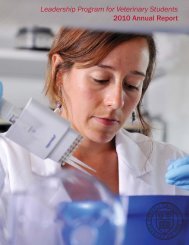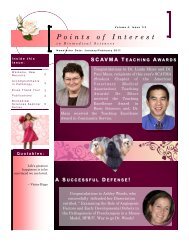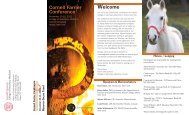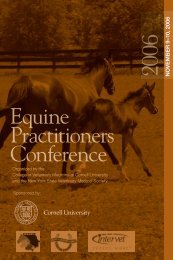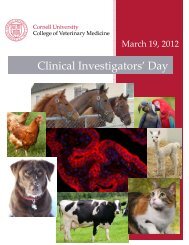From Classrooms to Clinics: - The College of Veterinary Medicine at ...
From Classrooms to Clinics: - The College of Veterinary Medicine at ...
From Classrooms to Clinics: - The College of Veterinary Medicine at ...
Create successful ePaper yourself
Turn your PDF publications into a flip-book with our unique Google optimized e-Paper software.
<strong>From</strong> Michigan <strong>to</strong> Machu Picchu<br />
Karley Hermans DVM ’11 grew up on a small farm in<br />
Midland, MI, surrounded by cows and sheep. She bought<br />
her fi rst steer when she was 13. And yet, as a young girl,<br />
veterinary medicine was hardly her <strong>to</strong>p career choice. “In<br />
fact, I swore th<strong>at</strong> I would never become a veterinarian,” said<br />
Hermans with a laugh. “At th<strong>at</strong> stage <strong>of</strong> my life, it just didn’t<br />
appeal <strong>to</strong> me.” However, as she worked with the lives<strong>to</strong>ck on<br />
her farm, she began <strong>to</strong> change her mind, resolving <strong>to</strong> focus<br />
exclusively on large animal medicine.<br />
Aft er completing four years <strong>of</strong> research in microbial<br />
genomics as an undergradu<strong>at</strong>e <strong>at</strong> Michigan St<strong>at</strong>e University<br />
and receiving fellowships from the American Society for<br />
Microbiology and the Crohn’s and Colitis Found<strong>at</strong>ion <strong>of</strong><br />
America, Hermans set her sights on veterinary school.<br />
She was drawn <strong>to</strong> Cornell by the strength <strong>of</strong> its faculty, its<br />
facilities, and by the research and clinical opportunities<br />
available for students interested in working with c<strong>at</strong>tle.<br />
“Pr<strong>of</strong>essors [Tom] Divers, [Chuck] Guard, [Daryl] Nydam,<br />
and [Ynte] Schukken are all very well known in the fi eld,”<br />
she said.<br />
In Ithaca, Hermans hit the ground running, getting<br />
involved in a gre<strong>at</strong> number <strong>of</strong> extracurricular activities<br />
and leadership roles. She has served as co-president <strong>of</strong> the<br />
Cornell chapter <strong>of</strong> the American Associ<strong>at</strong>ion <strong>of</strong> Bovine<br />
Practitioners, treasurer for the Swine Club, Colic Crew<br />
Chief, SCAVMA board member, and <strong>College</strong> represent<strong>at</strong>ive<br />
<strong>to</strong> Cornell’s gradu<strong>at</strong>e student assembly.<br />
In 2008, Hermans began working as a research assistant<br />
on a calf model <strong>of</strong> the parasite Cryp<strong>to</strong>sporidium parvum in<br />
Daryl Nydam’s lab. While Hermans had acquired research<br />
experience <strong>at</strong> the molecular level as an undergradu<strong>at</strong>e,<br />
she welcomed the opportunity <strong>to</strong> conduct clinical and<br />
transl<strong>at</strong>ional research and <strong>to</strong> learn about parasi<strong>to</strong>logy.<br />
“Karley has gre<strong>at</strong> potential as a veterinarian because she is<br />
bright, sees the big picture, is organized, and works hard,”<br />
said Nydam. “She has been instrumental in devising and<br />
testing methods <strong>to</strong> optimize our lab techniques, and she is<br />
RESEARCH ...<br />
equally adept out <strong>of</strong> the lab wrangling rowdy dairy calves<br />
and performing obstetrical procedures <strong>to</strong> deliver calves<br />
cleanly.”<br />
Nydam also helped connect Hermans with a research<br />
project in Peru through Cornell’s Expanding Horizons, a<br />
competitive grant program th<strong>at</strong> supports students working<br />
on animal research in developing countries. Hermans<br />
spent the summer <strong>of</strong> 2009 <strong>at</strong> the University <strong>of</strong> San Marcos<br />
in Lima, Peru, studying Ovine Pulmonary Adenoma<strong>to</strong>sis,<br />
a type <strong>of</strong> lung cancer, and developing a blood-based<br />
diagnostic test. Hermans would travel regularly <strong>to</strong> a<br />
130,000-head sheep farm high in the Andes <strong>to</strong> collect<br />
samples. In addition, she <strong>to</strong>ured the Alpaca industry in the<br />
Andes and worked with the Vicuña, an endangered camelid<br />
th<strong>at</strong> produces some <strong>of</strong> the fi nest fi ber in the world. Hermans<br />
also found time <strong>to</strong> travel widely throughout Peru, visiting<br />
Machu Picchu and the Sacred Valley.<br />
Looking forward <strong>to</strong> an academic career in large animal<br />
medicine, Hermans plans <strong>to</strong> spend several years aft er<br />
gradu<strong>at</strong>ion acquiring additional experience in a clinical<br />
setting before returning <strong>to</strong> academia for either a residency<br />
in internal medicine or a PhD.<br />
By Daniel Gurvich<br />
www.vet.cornell.edu 13



